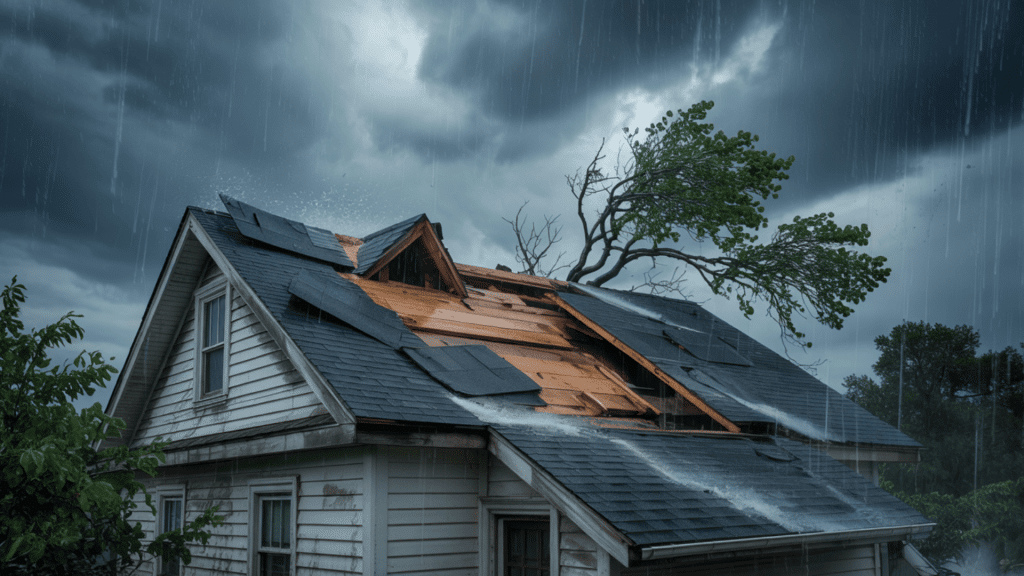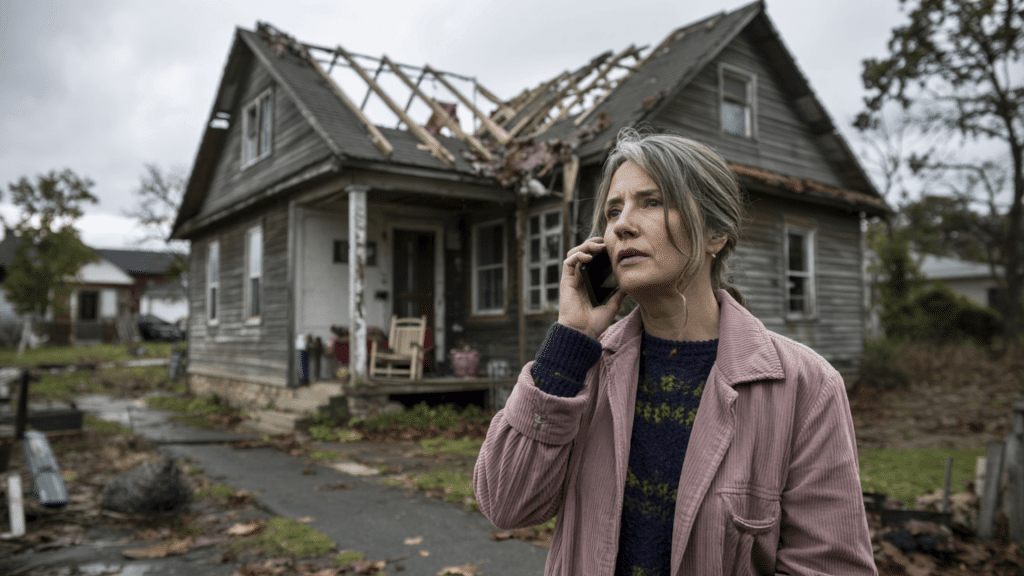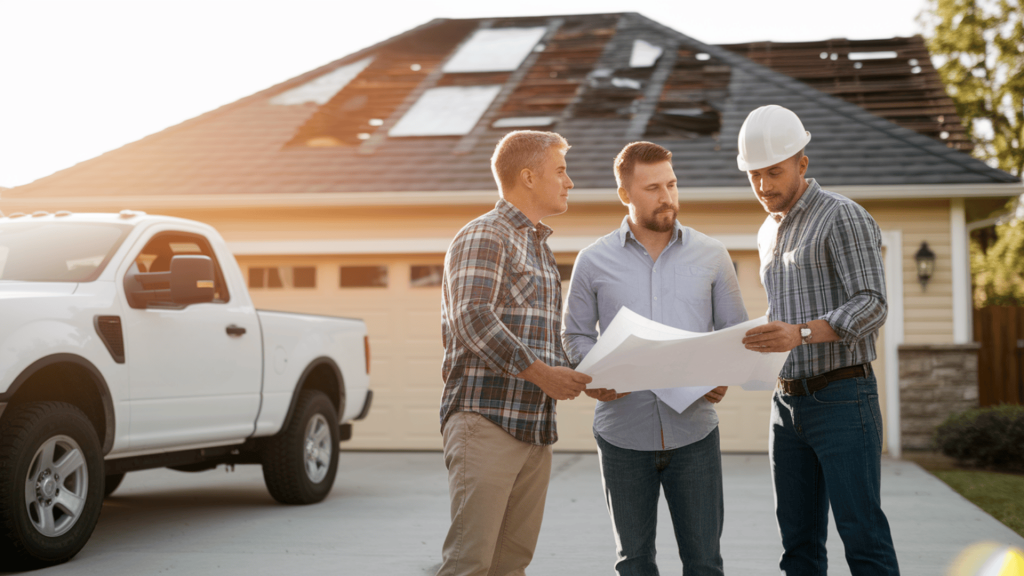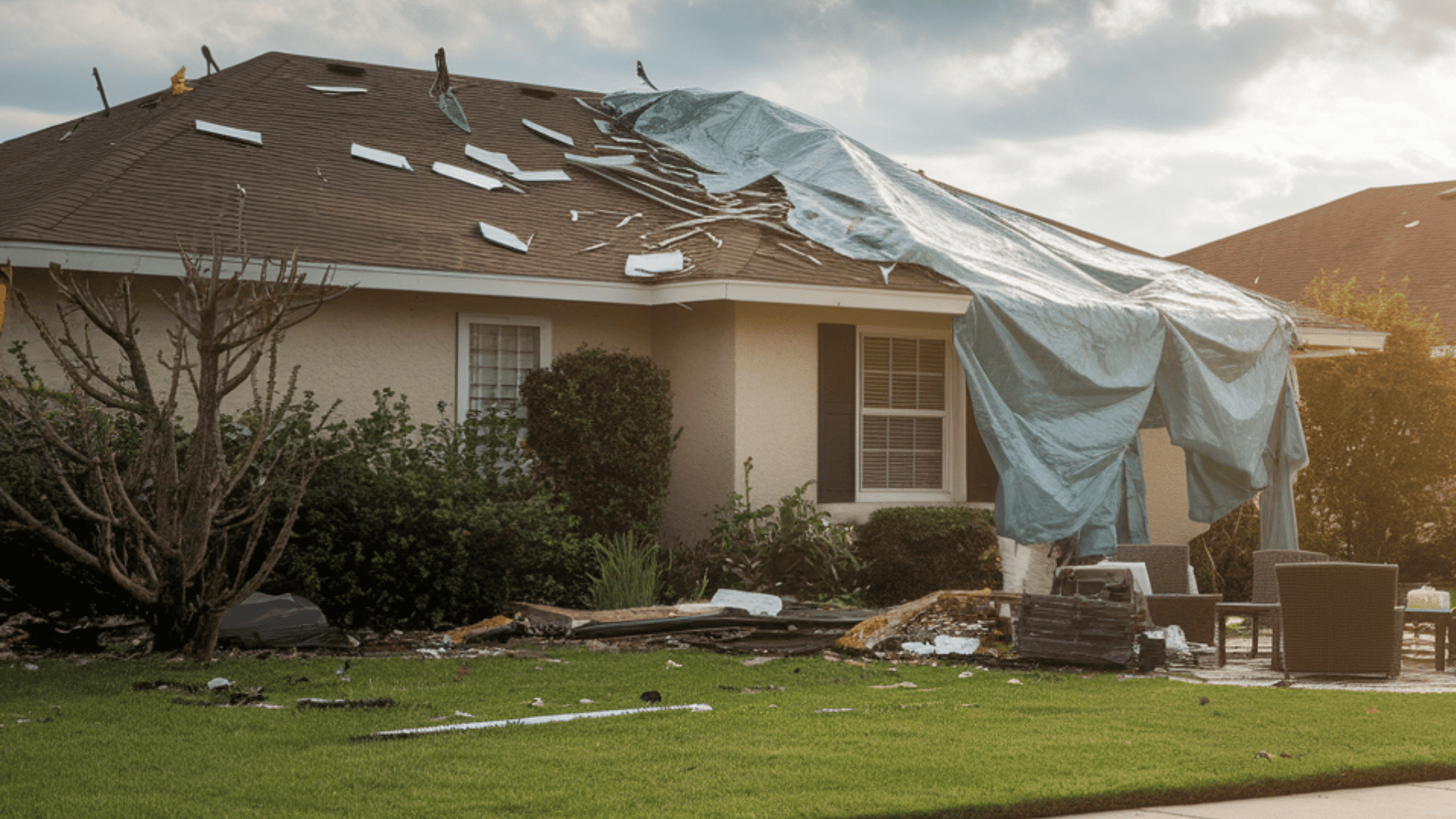When a hurricane hits your area, your roof takes the biggest beating. Strong winds, flying debris, and heavy rain can cause serious damage that puts your home at risk.
But don’t panic. Most roof damage doesn’t mean your house will collapse or flood right away.
The key is knowing what to do next. This guide will walk you through the steps to check your roof safely, document damage properly, and work with insurance companies and contractors.
If you’re dealing with missing shingles or major structural damage, following these steps will help protect your home and your wallet.
Remember, acting quickly but carefully is your best approach after any storm.
Stay Safe First – Don’t Rush to Check Your Roof
After a hurricane passes, you want to check your home right away. But safety comes first. Wait until the storm is completely over. Don’t climb on your roof; it might be wet and slippery. Look from the ground instead.
Most roof damage won’t cause leaks right away. Unless you see a big hole, you have time to make a plan. Walking on a damaged roof can make problems worse and put you in danger. Strong winds might still be present even after the main storm passes.
Be cautious of downed power lines around your property. Never touch or go near electrical lines that have fallen. Call your power company to report them right away.
How Hurricanes Damage Your Roof

Hurricanes bring multiple types of weather that can hurt your roof in different ways. Understanding these helps you know what to look for when checking for damage.
Wind is the biggest threat, with hurricane-force winds starting at 74 mph and sometimes reaching over 150 mph. These winds don’t just blow in one direction – they change angles and create pressure that lifts shingles from below.
When wind hits your house walls, it travels upward and puts strong pressure on the roof edges and corners. This lifting force is what tears off shingles and damages flashing. Heavy rain makes everything worse by getting into any openings the wind creates.
Flying debris like tree branches, patio furniture, and even pieces from other buildings become dangerous projectiles.
Hail can also occur during some hurricanes, creating dents and holes in your roof surface. All these elements work together to create damage that might not be obvious at first glance.
How to Inspect Your Roof After a Hurricane
After a hurricane, inspecting your roof thoroughly is crucial for your safety and to ensure a successful insurance claim.
Don’t rush this process; thorough documentation now will save you problems later. Always wait until the storm completely passes, and avoid going on your roof when it’s wet or windy.
Begin with a ground-level inspection by walking around your house and examining it from various angles. Take photos of missing or damaged shingles, dented gutters, debris, bent vents, loose tiles, and damaged flashing.
Use binoculars for a closer look at the damage that is not visible clearly. Look for curled shingle edges, granule loss, cracks, and exposed roof deck.
Check inside your home by entering your attic with a flashlight. Search for water stains on beams, wet insulation, daylight shining through, or active leaks.
Inspect interior ceilings and walls throughout every room for water stains, wet spots around fixtures, peeling paint, and soft drywall areas.
Document everything by taking clear photos from multiple angles and writing down the locations and sizes of damaged areas.
What to Do if You Find Damage

Finding damage to your roof after a hurricane can feel overwhelming, but taking the right steps in the correct order will help you protect your home and get the repairs you need. The key is to act quickly without rushing important decisions.
Here’s exactly what you need to do, step by step, to handle roof damage properly and work effectively with your insurance company.
Step 1: Take Photos of Everything
Document all the damage you can see. Take clear photos of:
- Damaged shingles from different angles
- Bent or broken gutters
- Water stains inside your home
- Any debris on your roof
- Close-up shots of specific damage
These photos will be helpful for your insurance claim later. Take more pictures than you think you need. It’s better to have too many than too few.
Step 2: Make Emergency Repairs
If you have a hole in your roof or missing shingles, you need to protect your home from more damage:
- Put a tarp over damaged areas if you can do it safely
- Use buckets to catch any dripping water
- Move furniture away from wet areas
- Turn off the electricity in rooms with water damage
Only do repairs you can handle safely from the ground or with a ladder. Don’t climb on your roof.
Step 3: Contact Your Insurance Company
Call your insurance company as soon as possible. Many companies have 24-hour claim reporting lines. They will:
- Start your claim process
- Give you a claim number
- Tell you what steps to take next
- Schedule an adjuster to look at your roof
Don’t wait to call. The sooner you report damage, the faster you can get help.
Step 4: Find a Good Roofing Contractor
You’ll need a professional to fix your roof properly. Look for contractors who:
- Are licensed and insured in your state
- Have good reviews from other customers
- Offer free damage inspections
- Can work with your insurance company
- Have been in business for several years
Watch out for storm chasers – contractors who go door-to-door right after storms. They often do poor work, overcharge, and might not be properly licensed. Good contractors don’t need to knock on doors to find work.
Understanding Your Insurance Coverage
When storm damage happens, many homeowners realize they don’t fully understand their insurance. Knowing the basics ahead of time helps you ask better questions and avoid surprises when it’s time to file a claim.
- Know your coverage details: Check what types of damage are included, your deductible amount, and whether you have Replacement Cost Value (RCV) or Actual Cash Value (ACV) coverage.
- Understand policy types: RCV pays for a new roof at current prices, while ACV only covers the depreciated value of your old roof.
- Be aware of hurricane deductibles: These are often higher than regular deductibles and might be a percentage of your home’s value rather than a flat dollar amount.
- Remember deductible requirements: You must pay your deductible before insurance pays anything, which can impact your decision to file a claim.
- Be present during adjuster visits: Have your contractor there if possible to ensure all damage gets noted and documented properly.
- Document everything: Ask the adjuster what damage they found, what’s covered, and your next steps, then get their report and repair estimate in writing.
- Verify accuracy: Check all reports and estimates for accuracy to ensure you get the coverage you deserve.
The Claims Process Timeline
Filing an insurance claim after a hurricane can feel overwhelming, but understanding the process helps you stay on track. Here’s a simple timeline of what to expect after reporting damage.
| STAGE | DETAILS |
|---|---|
| Initial Claim Filing | Report damage within 60 days (varies by insurer). Call immediately once the damage is found. |
| Adjuster Inspection | Typically scheduled within a few days to a week after filing. It may take longer during widespread disaster events. |
| Claim Decision | After inspection, the insurance company decides to approve or deny the claim. This may take a few days to a few weeks. |
| Getting Your Money | If approved, payment is issued. For RCV (Replacement Cost Value) policies, two payments may be issued: one initially and another after repairs. |
Every insurance company is different, but staying organized and acting promptly can expedite your claim. Document everything and follow up if you don’t hear back promptly.
Finding a Trustworthy Roofing Contractor

When hiring a contractor, don’t rush; start with thorough research. Ask friends, neighbors, and your insurance company for recommendations, and check Better Business Bureau ratings.
Get at least three estimates comparing costs, materials, timelines, and warranties. Verify contractors have valid state licenses, liability insurance, workers’ compensation, and local references.
Watch for red flags: avoid contractors who go door-to-door after storms, demand large upfront payments, lack local references, can’t provide insurance proof, or pressure you to sign immediately.
Taking time to research credentials and get multiple quotes helps you find a trustworthy professional and avoid costly mistakes. Focus on qualified, insured contractors with solid reputations.
Preventing Future Hurricane Damage
Taking steps now can help protect your home from future hurricane damage. Here are simple, proactive measures to strengthen your property before the next storm hits.
- Inspect your roof annually, especially before hurricane season, and repair small issues early.
- Trim overhanging branches and remove dead or weak trees near your home to prevent roof damage.
- Clean gutters at least twice a year to stop water from backing up under shingles.
- Upgrade to stronger roofing materials like metal roofing (rated for 140–150 mph winds), architectural shingles, or impact-resistant options.
- Secure outdoor items such as patio furniture, grills, trash cans, and garden tools to prevent them from becoming dangerous debris.
- Create a seasonal checklist to prepare your property in advance of each hurricane season.
Hurricanes are unpredictable, but your preparation doesn’t have to be. A little maintenance each season goes a long way in keeping your home safe.
The Bottom Line
Hurricane damage to your roof is serious, but you can handle it with the right approach. Remember to stay safe, document everything, and work with trusted professionals.
Don’t wait to address damage – small problems become expensive ones quickly. Contact your insurance company first, then find a licensed contractor who can guide you through the repair process. Keep all your photos and receipts organized for insurance claims.
If you’re dealing with roof damage right now, start with the safety steps in this guide. Most importantly, don’t try to handle major repairs yourself.
Need help with hurricane roof damage? Contact a certified roofing contractor today for a free inspection. Your roof protects your biggest investment – don’t take chances with storm damage repairs.


